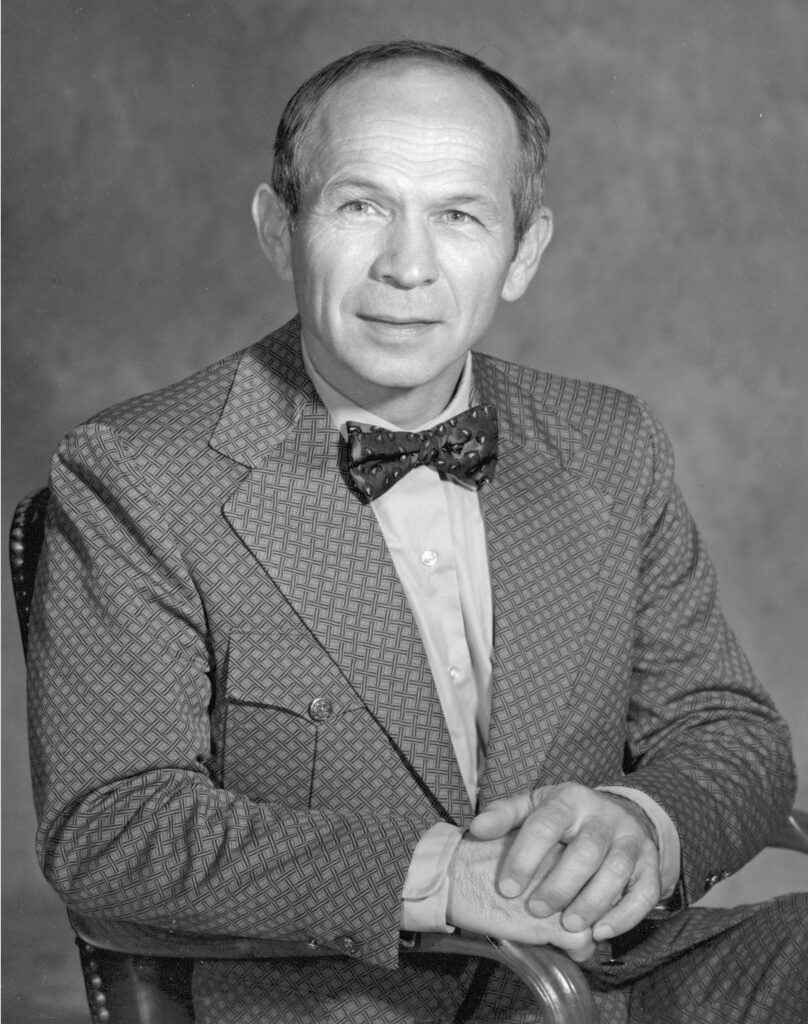Maxime A. Faget was the Director of Engineering and Development at the Manned Spacecraft Center (now the Johnson Space Center), for the National Aeronautics and Space Administration (NASA), in Houston, Texas. He served on the Steering Committee, which helped the NASA Administrator make Project Mercury policy decisions. Later he was responsible for technical support of the Gemini and Apollo manned space flight programs and advanced studies into space systems. As a NASA member of the Polaris Missile Steering Task Group, he also contributed to the design of that submarine-launched missile.
Maxime “Max” Faget was born at Stam Creek, British Honduras, on August 26, 1921. His father noted physician Dr. Guy Faget was conducting research on tropical diseases there for the British government at the time (he later developed the first successful treatment for leprosy). Max attended San Francisco Junior College in San Francisco, California, before receiving a Bachelor of Science degree in Mechanical Engineering from Louisiana State University in 1943. He then served as a naval officer during World War II, seeing considerable combat in the Pacific Theater as a submarine officer.
In 1946, Faget went to work for the National Advisory Committee for Aeronautics (NACA), NASA’s precursor. At the Langley Aeronautical Laboratory in Hampton, Virginia, he designed ramjets before being assigned to the propulsion-and-performance team that helped develop the X-l5 the experimental plane that flew later flew at Mach 6 speeds.
When NACA was transformed into the civilian space agency NASA in 1958, Maxime Faget joined the transition team and later the Space Task Group organized to manage Project Mercury. He headed the flight systems division that designed America’s first manned spacecraft, the Mercury capsule. A manned spacecraft must protect its occupant from high G (gravity) forces and atmospheric friction upon re-entry; Faget successfully argued for a blunt bodied capsule because it could slow down high in the atmosphere where the friction and heat were less.
As one of the 35 engineers originally assigned to the Mercury project, Faget devoted time to follow-on programs after Mercury would end, and led the initial design and analysis teams that studied the feasibility of a flight to the Moon. As a result of his work, Faget was appointed chief engineer at the Manned Spacecraft Center in Houston (now the Johnson Space Center) at the start of the Apollo program in February 1962.
In this role, Maxime Faget helped to design the Apollo capsule and service module for lunar landings. Due to the problems of launching the capsule as a single unit he converted the Apollo design into two parts, a command-service module that would orbit the moon and a separate lunar-landing craft. His innovation would play a key role in the success of the Apollo lunar landings.
A few months before the Apollo 11 Moon landing in July 1969, Faget organized a team to study the feasibility of a reusable spacecraft. They produced the final design of the space shuttle that lifted off from Kennedy Space Center in April 1981. Max Faget retired from the space agency after the second shuttle flight in November 1981. In 1982 he helped to found one of the early private space companies, Space Industries Inc. As a visiting professor, Faget taught graduate level courses at the Louisiana State University, Rice University, and the University of Houston.
Maxime Faget wrote many technical papers on aerodynamics, rocketry, high-speed bomb ejection, reentry theory, heat transfer, and aircraft performance. He was the co-author of a textbook, Engineering Design, and Operations of Spacecraft, and wrote another, Manned Space Flight. Faget held joint patents on the “Aerial Capsule Emergency Separation Device” (escape tower), the “Survival Couch,” the “Mercury Capsule,” and a “Mach Number Indicator.”
Among the many awards he received was the Arthur S. Fleming Award in 1960, the Golden Plate Award in 1961 (presented by the Academy of Achievement), the NASA Medal for Outstanding Leadership in 1963, and in 1965 the Award of Loyola. In 1966 the University of Pittsburgh awarded him an Honorary Degree of Doctor of Engineering.
Maxime A. Faget died at his home in Houston on October 9, 2004. He was 83.
His passing was mourned by his coworkers: “Without Max Faget’s innovative designs and thoughtful approach to problem-solving, America’s space program would have had trouble getting off the ground,” said NASA Administrator Sean O’Keefe. “He also was an aeronautics pioneer. In fact, it was his work on supersonic flight research that eventually led to his interest in space flight.”
“Max was a genuine icon,” said NASA’s Associate Administrator for Space Operations William Readdy. “A down-to-earth Cajun with a very nuts-and-bolts approach to engineering. He contributed immeasurably to America’s successes in human space flight. His genius allowed us to compete and win the space race to the Moon.”
“Max Faget was truly a legend of the manned space flight program,” said Christopher C. Kraft, former Johnson Space Center director. “He was a true icon of the space program. There is no one in space flight history in this or any other country who has had a larger impact on man’s quest in space exploration. He was a colleague and a friend I regarded with the highest esteem. History will remember him as one of the really great scientists of the Twentieth Century.”

